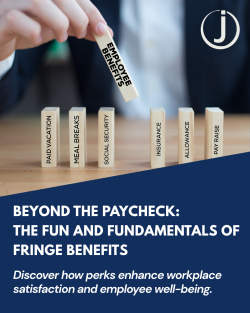Beyond the Paycheck: The Fun and Fundamentals of Fringe Benefits
When it comes to employee compensation, there’s more than just the paycheck. Enter fringe benefits—the perks that add flavor to the employment experience. Think of them as the sprinkles on your compensation cupcake.
What Exactly Are Fringe Benefits?
Fringe benefits are additional compensations provided by employers beyond regular wages or salaries. These can range from health insurance and retirement plans to gym memberships and company cars. Essentially, they’re the extras that make a job offer more enticing.
Taxable vs. Nontaxable: The IRS’s Take
Not all fringe benefits are treated equal in the eyes of the IRS. Some are taxable, while others are not.
Taxable Fringe Benefits: These benefits must be included in the employee’s taxable income. Examples include:
- Personal use of a company car
- Cash bonuses
- Paid personal time off
Employers must report these on the employee’s W-2 form and withhold appropriate taxes.
Nontaxable Fringe Benefits: These benefits are excluded from taxable income, provided they meet certain IRS criteria. Examples include:
- Health insurance
- Educational assistance
- Dependent care assistance
- Group-term life insurance (up to $50,000)
It’s essential to consult IRS guidelines to determine the taxability of specific benefits.
Fringe Benefits for Non-Employees
Fringe benefits aren’t exclusive to employees. Independent contractors and partners can also receive them. However, the reporting differs:
Independent Contractors: Report benefits on Form 1099-NEC.
Partners: Report benefits on Schedule K-1 (Form 1065).
Note: S corporations should treat 2% shareholders as partners for fringe benefit purposes.
The Strategic Advantage of Offering Fringe Benefits
Beyond the obvious perks, fringe benefits play a strategic role in business:
Attracting Talent: Competitive benefits packages can lure top-tier candidates.
Employee Retention: Benefits such as health insurance and retirement plans can increase job satisfaction and reduce turnover.
Tax Advantages: Some benefits can be deducted as business expenses, offering financial advantages to employers.
A Dash of Humor: The Perk Perspective
Imagine offering free coffee as a fringe benefit. While it might not seem significant, for some employees, it’s the daily fuel that powers productivity. Just ensure the coffee doesn’t lead to a caffeine-induced spreadsheet frenzy!
Final Thoughts
Fringe benefits are more than just add-ons; they’re an integral components of a comprehensive compensation strategy. By understanding their nuances and tax implications, employers can craft packages that not only comply with regulations but also resonate with employees. For a deeper dive into fringe benefits and their tax implications, consult IRS Publication 15-B.
Note: This blog is for informational purposes only and does not constitute legal or tax advice. Always consult with a professional for specific guidance
